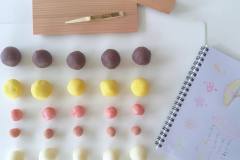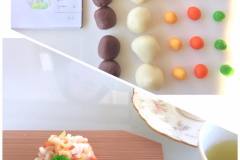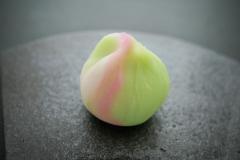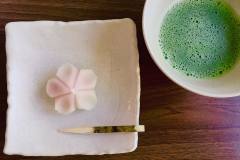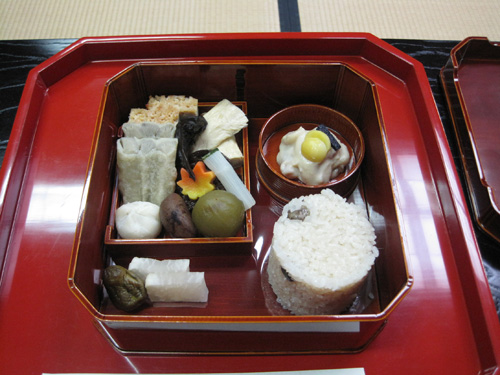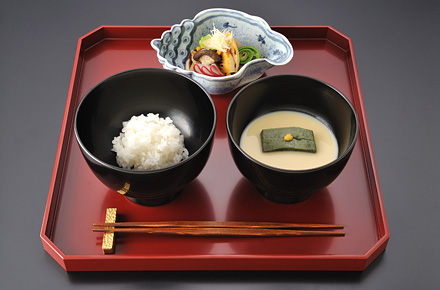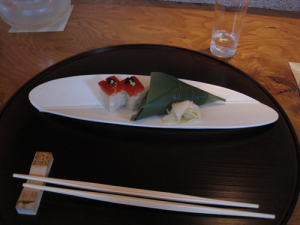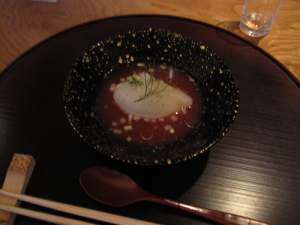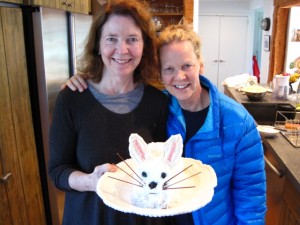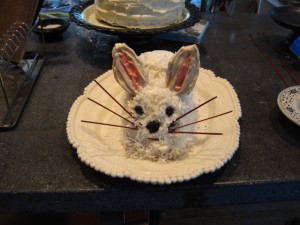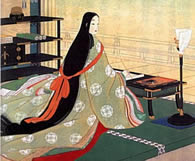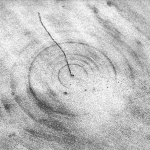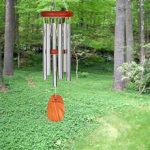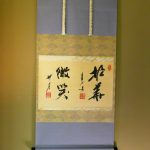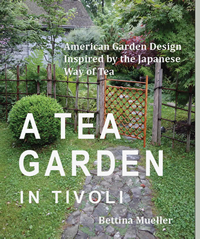Sweets for tea
I’m obsessed with Japanese sweets. Particularly obsessed with making pure white sweets, which I have not yet mastered.
The main ingredient in all the sweets is a bean paste called An. It can be made with red azuki beans or with white lima beans, or any large white bean. When you add sugar to the bean paste, it turns an off-white. Perfect for coloring.
You can make all sorts of shapes with marvelous colors. I write about this more in detail in my cookbook The World in a Bowl of Tea which you can order online here.
But this is the sweet with it’s pure white that I cannot yet master. It involves making a glutinous mochi mixed with the An. So beautiful and illusive!
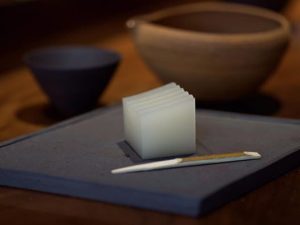
Things worth seeing
I find it strange that Sei Shonagon doesn’t have a list for favorite foods in her Pillow Book. Certainly food is a compelling topic. But for her, ink or paper or the color of one’s dress is more noteworthy. She does list “Things worth seeing”.
Certainly the food in Japan would fit. The sweets, bento boxes and kaiseki meals are all visually amazing besides being incredibly delicious. I haven’t stopped longing for Kyoto Udon.
I will add Japanese food to my own list of “Things worth traveling for” or “Things about Japan that one longs for”.
Here are slides of some of the great food I had in Japan when I was last there. I notice that I use the word “best” over and over again when describing the photos. Every meal was the best. Every place we went was the best. Over and over again.
A basket for sweets
Three friends came for tea the other morning. Even at 10:30 the July heat was intense. My task in the tearoom was to create a feeling of coolness. Baskets are a wonderful way to do this.
I made the green sweets I called ‘Jewels of Moss’ which gives an image of a shady cool spot by a stream with soft green moss growing over stones. The little sweets to the right are called Kampeto, pressed sugar clusters.
This is a Japanese made basket. I don’t know the name of the maker. It’s modern and I found it at the Cooper Hewitt Museum in NYC. My guests loved it.
The sweets are easy to make. The ingredients are simple. Don’t be shocked by the amount of sugar.
11-13 g Kanten (agar agar)
1 3/4 C water
2 Cups sugar
flavor or color
1 – Kanten or “agar agar” is a type of seaweed sold in bars. Soak the Kanten in the water for about an hour.
2 – Bring the water and kanten mixture to a boil, then reduce to a very low flame and allow the mixture to simmer until all of the kanten has dissolved (around 15 minutes). It is important to keep the lid on the pot so as not to loose much moisture, but keep it ajar to insure the liquid does not boil over.
3 – Strain the kanten mixture through a sieve, into the sugar which you would have prepared in another pot.
4 – Cook on low to medium flame, watching carefully. Do not let this boil over. After about 15 minutes, small bubbles will form around the edges. Eventually, the mixture will become more viscous. It is the right consistency when little threads form between the fingers when you pinch a little of the hot mixture. If these threads break it is not done yet.
5 – Here is the point where you could add a little food coloring and flavoring. You can experiment with different flavors or fruit syrups. It is important to note that fruit juices will not work as the acid in the fruit causes the kanten to lose its ability to congeal. Liquors and wines (like plum wine) can also add a nice flavor, but the drying time will be longer.
6 – Pour into a pan or an empty, clean milk or juice carton. While the kanten is cooling take a piece of paper and skim off any bubbles that appear.
7- After one day or even a few hours the kanten will have set. Remove the jellied brick. If using the milk carton just tear it off.

This is a Japanese pan with removable insert. I slid a knife around the outside of the Kanten to remove.

Put the cut crystals on parchment paper and loosely cover with a paper towel. Keep covered for two to three days. Turn the sweets every so often so that all sides get exposed to air. After a few days (depending on the humidity) the outside will get a sugary crunch coating.
After completely dry, you can store these sweets in a tin for up to 2-4 weeks.
In case you don’t want to make them, here’s a place that makes these sweets which they call Sea Glass. They look beautiful. Yume Asian Confections
We had high hopes
Once in awhile my friend Seiko and I treat ourselves to a Kaiseki meal at a new restaurant. Kaiseki is a seven course meal served during a tea ceremony made up of small tidbits of seasonal food. Last year we went to Kajitsu which specializes in Shoin cuisine, Zen temple cuisine. We loved everything about it: the food, the atmosphere, the presentation were all sublime.
This past weekend we went to Brushstroke. They describe the restaurant as Kaiseki, a French/Japanese fusion “concept”. We should have been clued in by the word “concept”.
We sat at the cooks bar and looked into the busy kitchen. The restaurant was filled mostly with Japanese who are fascinated to try out their cuisine with a French twist. The weather had turned very hot, the air conditioning had broken and the place was stifling. We were encouraged though when the waiter brought us complimentary cold sake and a small bowl of lemon ice with a promise of more wonderful treats to come.
I ordered the eight course vegetarian menu and Seiko had the tasting menu which turned out to be six courses. As the hours ticked by Seiko sat with an empty tray while I was served course after course. It felt rude to be eating while she sat waiting. It wouldn’t have been so obvious and painful if the courses had been served quickly one after the other. After all, they were just tidbit size.
We were there for a sweltering three hours. Something had gone wrong in the kitchen. The cooks looked busy enough, but we waited 20 or so minutes at least in between courses.
Some of the food was good, like the watermelon soup with a quenelle of fennel ice. But the dashi broth, which is considered the essence of Kaiseki and used for the soups and broths, was gloopy, viscous and tasteless. Most unpleasant.
On the whole, we couldn’t wait to leave and get out into the fresh air. Thumbs down for Brushstroke.
Bunny cake – among life’s most splendid things
It’s Easter and my sister made a bunny cake.
I contributed the ears and tail made from meringue. The nose is a blackberry and the eyes licorice jelly beans.
We colored some cocoanut green and spread it around the bunny to look like grass.
It’s really easy to make. Here’s a diagram. Be sure to put frosting between the two halves. Don’t make paper ears. Make meringue. Color a small amount pink for the inside of the ears.
 Here’s a better photo, but we still haven’t put in the grass!
Here’s a better photo, but we still haven’t put in the grass!

